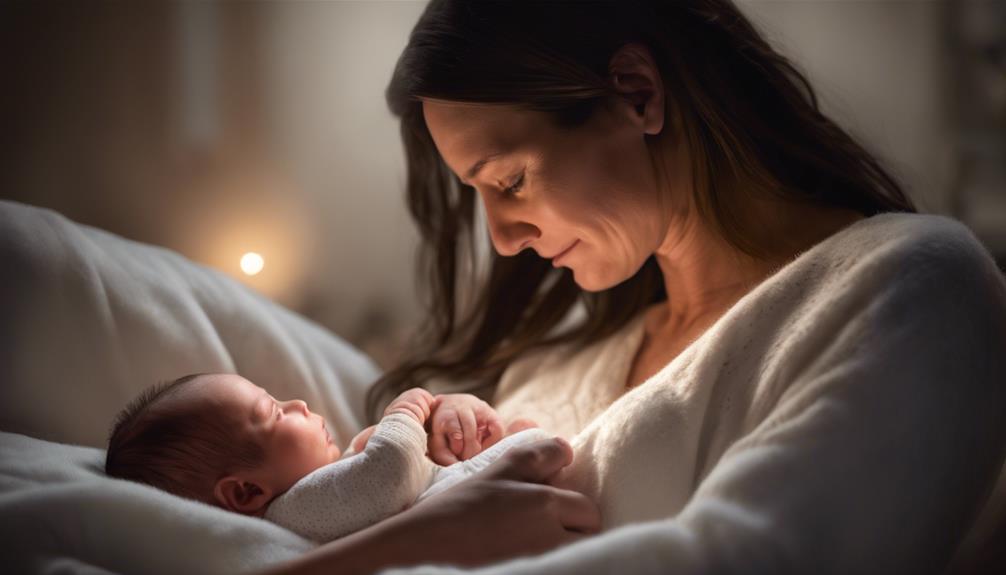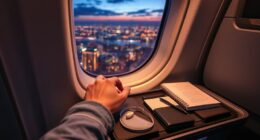Have you ever wondered why newborns seem to startle and jump in their sleep? It's a common behavior that often leaves parents puzzled.
Understanding the reasons behind these sudden movements can provide insight into the fascinating world of infant sleep patterns and development. From the Moro reflex to dream activity, there are several intriguing explanations for why babies exhibit these startling movements during their slumber.
Curious to uncover the mysteries behind this adorable yet puzzling phenomenon?
Key Takeaways
- Sleep twitches aid in neural maturation and motor skill development.
- Myoclonic twitches during REM sleep activate limb coordination circuits.
- Sudden muscle contractions support neural pathway formation and brain maturation.
- Startle reflex signifies healthy nervous system and safety response to stimuli.
Normal Neurological Development
As we explore the topic of typical neurological development in newborns, it becomes evident that their sleep twitches, commonly seen as jumping movements, play an important role in the maturation of their nervous system. These involuntary twitches, often referred to as myoclonus, occur during the REM sleep phase and are a critical part of the baby's brain development. The brain is actively forming connections during this time, and these movements help in activating circuits that are essential for limb coordination.
It is fascinating to observe how these twitching patterns in newborns align with their progression in acquiring new motor skills. The sensorimotor development in babies is intricately linked to these sleep twitches, as they aid in laying down the foundation for future movement abilities. By allowing these movements to occur naturally, we're fundamentally supporting the infant's neurological growth and paving the way for smoother coordination of their limbs in the future. Embracing these sleep twitches as a normal part of a baby's development journey is fundamental for their overall well-being and growth.
Moro Reflex Response

The Moro reflex, also known as the startle reflex, serves as a vital mechanism in newborns, triggered by sudden movements or loud noises, causing the baby to instinctively throw their arms out. This natural response is a sign of a healthy nervous system and a primitive survival instinct in infants. When a baby experiences a sudden change in their environment, like a loud noise or a quick movement, this reflex kicks in, helping the baby cling to their caregiver as a form of protection.
Understanding the Moro reflex is important for caregivers as it allows them to comfort and support the baby during these moments of startle. It's important to create a calm and soothing environment to help the baby feel secure after experiencing the reflex response. As the baby grows and their nervous system matures, this reflex gradually diminishes, usually between 3 to 6 months of age. So, next time you see your newborn suddenly throw their arms out, remember it's just their Moro reflex at work, a fascinating part of their development.
Sudden Muscle Contractions

During sleep, newborns experience sudden muscle contractions, known as sleep myoclonus, which often cause them to jump. These muscle twitches play an important role in their sensorimotor development and brain maturation. Sleep myoclonus helps in the formation of neural pathways, aiding in the coordination of movements as newborns grow. These twitches, commonly observed during REM sleep, occur in various body parts like legs and arms, indicating healthy neural connections. The jumps you see in your little one during sleep are a natural and harmless part of their development.
| Key Points | ||
|---|---|---|
| Neural Pathways | REM Sleep | Muscle Twitches |
| Sensorimotor Development | Coordination | Brain Development |
Understanding and observing these muscle contractions can give parents insight into the intricate process of their newborn's growth. Embrace these jumps as signs of a healthy and active developing brain, creating the foundation for future movements and coordination.
Dreaming and REM Sleep

In the deepest stage of sleep, characterized by dreaming and muscle twitches, newborns jump as a result of rapid eye movement (REM) sleep. Here's why this happens:
- Myoclonic Twitches: During REM sleep, newborns may experience myoclonic twitches, which are brief, involuntary muscle movements that aid in neural development.
- Brain Circuit Activation: These twitches activate circuits in the brain related to limb awareness and coordination, contributing immensely to motor skill development.
- Neural Pathway Organization: Myoclonic twitches play a critical role in programming the brain and organizing neural pathways, potentially synchronizing developing brain structures in newborns.
- Neurodevelopmental Importance: Understanding the connection between newborn twitching during REM sleep and motor development is essential for evaluating typical development and recognizing any potential neurodevelopmental issues.
These involuntary movements during REM sleep not only reflect a healthy brain but also signify the intricate process of motor development in newborns.
Startle Response to External Stimuli

At times, newborns startle in their sleep due to the Moro reflex, an instinctive response triggered by sudden stimuli. This automatic reaction causes them to throw out their arms, extend their legs, and arch their back. The startle reflex is a vital mechanism that helps newborns respond to potential threats or changes in their environment. While this reflex can be valuable for their safety, it may also disrupt their peaceful sleep patterns if activated frequently.
Understanding and managing the startle reflex is essential in creating a serene sleep environment for newborns. By minimizing external stimuli that trigger this response, such as sudden noises or movements, caregivers can help newborns experience more restful sleep. Responding with gentleness and reassurance when a startle occurs can also aid in soothing the baby back to sleep, promoting a sense of security and calmness in their sleep environment.
Frequently Asked Questions
Why Does My Newborn Randomly Jump in His Sleep?
We've noticed our newborn jumping in sleep, which is quite common. These sudden movements are myoclonic twitches, helping with muscle development. They're harmless and show your baby's healthy sensorimotor system at work. Worry not!
Why Does My Newborn Jump Suddenly?
We've noticed our newborn jump suddenly in their sleep. It's normal due to developing reflexes and the startle reflex. These jumps help with muscle coordination and can be triggered by dreams or sleep cycle changes.
Is It Normal for Babies to Startle in Their Sleep?
Yes, it's normal for babies to startle in their sleep. Immature nervous systems cause involuntary movements. Sleep startles decrease as they mature. Sudden movements are hypnagogic jerks. Moro reflex helps with fight-or-flight response and neurological development.
How Do I Know if My Baby Is Having a Seizure in His Sleep?
If your baby is having a seizure in their sleep, signs may include limb stiffening, repetitive movements, jerking, rolling eyes, altered breathing, or unusual sounds. Promptly consult a pediatrician if movements seem abnormal or intense for proper evaluation.
Conclusion
To summarize, it's perfectly normal for newborns to jump in their sleep for a variety of reasons. From practicing their motor skills to responding to external stimuli, these movements are all part of their healthy development.
So next time you see your little one bouncing around in their sleep, remember that they're just mastering their ninja moves like a pro! Just sit back, relax, and enjoy the adorable show.









